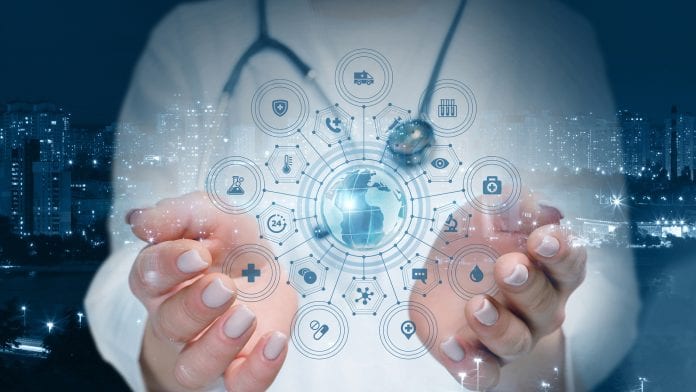
In this article software and robotics expert, Dr Antonio Espingardeiro, Member of the Institute of Electrical and Electronics Engineers, discusses ‘the need for adaptable infrastructure to cope with health crises’ and how technology is addressing healthcare challenges.
Just last year, health secretary Matt Hancock warned that the NHS must adopt new healthcare technology – including IoT devices, robots and artificial intelligence (AI) – if it is to survive[1].
Today, global events have forced the healthcare industry’s hand. We have witnessed the sudden rise of telehealth platforms, the use of AI in diagnosis and realised the importance of ‘secure, reliable and timely data’ enabled by modern telecommunications, as NHSX is used to track and manage the development of Covid-19 in real-time[2].
Speaking more generally, health-tech innovations are essential – but the true potential and capabilities are yet to be fully realised. As this pandemic has shown, there is an urgent need for an adaptable infrastructure to cope with such health crises right now, and in years to come.
Technology and healthcare challenges
Before exploring this further, we must acknowledge a challenge that many countries have been facing for many years before this current crisis – an ageing population that’s growing exponentially. There has always been demand for scalability and quality within healthcare. With the global population living longer, and many people living with noncommunicable diseases (more than 400 million people across the globe suffer from diabetes alone)[3] that require regular medical checks, we must utilise technology in order to fully democratise healthcare.
AI is already in use, through the application of machine learning. This enables medical professionals to better understand certain health conditions. For example, through AI programs, scientists can explore the huge volume of data that makes up the DNA in the blood of cancer patients. With this insight, they can detect specific mutations which will eventually be used to classify those most at risk or identify those that may perhaps require further consultation[4].
Through pattern recognition, AI has the potential to enable patients to be screened with greater efficiency and scale, and assist doctors with overall disease management. As a result, they will eventually be able to improve or better coordinate healthcare plans for long-term treatment.
IoT sensing technologies
Similarly, IoT sensing technologies are allowing us to approach major health threats differently, mainly though forms of supervision. In the consumer market, we are already seeing the adoption of smart watches and other wearables that can track our heart rate or exercise output – but as we begin to realise the potential of these types of technologies, they will be put to even better use in the remote monitoring of patients or improving medical systems of record.
In time, it’s possible that we will begin to see sensors dispersed within our bodies – to track everything from glucose, to oxygen to temperature – or smart devices installed in our home with remote access for healthcare professionals. With the broader adoption of IoT devices, daily health measurements will generate vast amounts of biometric readings and naturally, we will require more advanced machine learning (ML) algorithms to make sense of this data. Once the data is harvested and computational power is applied through machine learning, clinicians and doctors can begin to identify emerging patterns. The results will then be presented to the patient allowing comprehensive healthcare management and regular reports.
Covid-19: AI and the power of data
All that being said, Covid-19 is brand new territory for us, and as such, we must approach things differently. Again, AI can be used to identify high-risk groups and possibly diagnose potential patients – studies show that those with underlying health conditions or chronic illnesses, such as respiratory and cardiovascular disease, obesity or cancer have a greater risk of complications from the virus[5]. The technology could even assist in the discovery of a new therapy or vaccine. However, the problem now is that there isn’t enough data relative to COVID-19 that can be used to train machine learning algorithms or broader AI. In fact, IBM estimated that 80% of health data is invisible to current systems because it remains unstructured[6].
As the Department of Health and Social Care outlined in a recent post, Covid-19 requires ‘real-time information’[7]. Once NHS England and NHS Improvement work together to bring multiple data sources into a single data store, we will be able to apply mathematical models and fully utilise AI. This will identify patterns and base predictions that may help us better understand how the virus manifests in certain conditions, or even map its origins.
A final form of AI which may become popular as a result of Covid-19, is the use of chatbots. As many of us self-isolate or continue to stay at home, natural language processing will enable us to better understand people’s mental and physical conditions. Online chatbots or ‘robot-doctors’ will eventually be able to collect information, advise on certain conditions and forward cases to medical professionals – delivering the scalability that the NHS needs, so that doctors can reach the highest number of people, whilst ensuring the safety of our nurses and doctors who can perform a diagnosis at a safe distance.
In summary, crises such as this reveal much about our current healthcare systems. Medical professionals will increasingly tackle these problems with new technologies and, in doing so, adapt our infrastructure to meet evolving requirements.
By Dr Antonio Espingardeiro
Guest author
Member of the IEEE
Software and robotics expert
[1] https://www.telegraph.co.uk/news/2019/04/23/hancock-nhs-must-adopt-new-technology-will-not-survive/
[2] https://healthtech.blog.gov.uk/2020/03/28/the-power-of-data-in-a-pandemic/
[3] https://www.theguardian.com/global-health-progress/2020/apr/06/global-health-policy-can-we-manage-the-ever-increasing-rise-of-diabetes
[4] https://www.theguardian.com/society/2020/mar/25/ai-program-could-check-blood-for-signs-of-lung-cancer
[5] https://www.bmj.com/content/368/bmj.m1198
[6] https://www.ibm.com/watson-health/learn/artificial-intelligence-medicine
[7] https://healthtech.blog.gov.uk/2020/03/28/the-power-of-data-in-a-pandemic/







